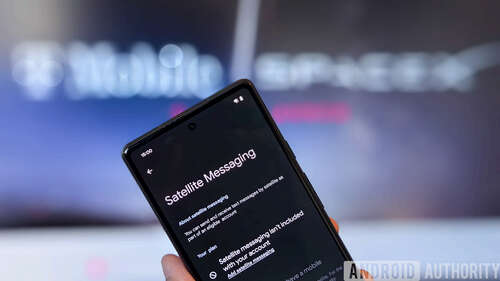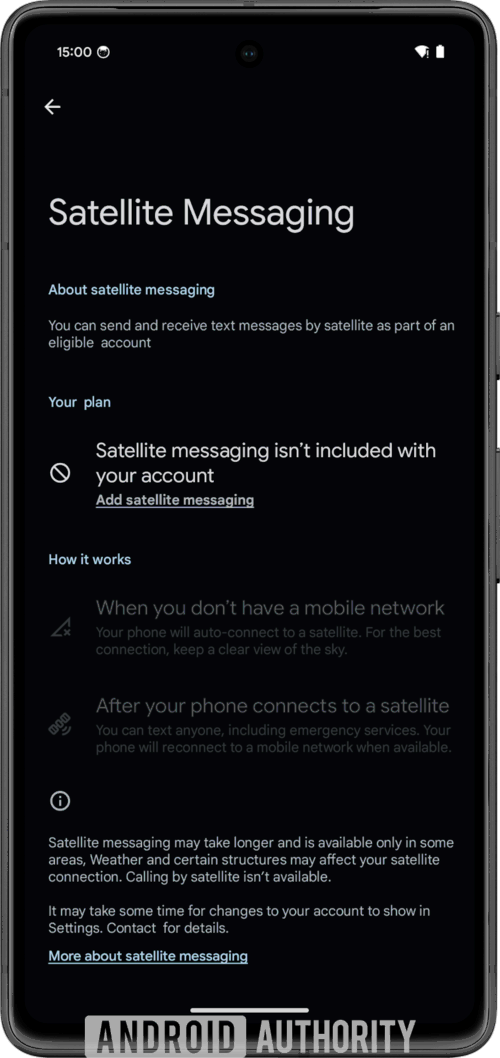
Mishaal Rahman / Android Authority
TL;DR
- Code within the latest Android beta reveals Google is preparing to release a built-in satellite messaging feature in partnership with T-Mobile.
- There are many areas where cellular connectivity is either spotty or nonexistent because the nearest cell tower is too far away, but low Earth orbit (LEO) satellites can still be reached.
- Smartphone vendors have been racing to include satellite connectivity support in their devices ever since Apple rolled it out on the iPhone 14.
Cell towers blanket most parts of the United States and other developed nations, but they still don’t reach many remote areas. If you’re ever in an emergency without cellular connectivity, you’d better hope you were prepared for such a situation, let someone know beforehand about your plans, find an area with limited connectivity, or use a device capable of satellite connectivity to send an emergency SOS. The vast majority of Android smartphones currently don’t support sending text messages via satellite, but Google might be changing that in Android 15.
When Apple launched the iPhone 14 series, one lauded feature was Emergency SOS. Emergency SOS uses special phone antenna hardware to establish a direct connection with low Earth orbit (LEO) satellites. This lets the iPhone send text messages to emergency services without cellular connectivity. During the devastating Maui wildfires last August, several people were able to text for help after the fires destroyed the local cellular infrastructure.
But what about Android satellite connectivity?
The iPhone’s Emergency SOS feature has more than proven its worth, which is why it’s no surprise that Android smartphone makers are itching to implement their own version. The (now defunct) Bullitt Group was the first to respond to Apple with its Motorola-branded Defy 2 and CAT S75 smartphones announced in early 2023, but it took months for the next Android smartphone to be announced with satellite connectivity (the HUAWEI Mate 60 Pro).
Apple has satellite connectivity and Android doesn’t yet, at least not at the same level as Apple. That needs to change.
Since then, we haven’t heard of any new Android smartphones with satellite connectivity support, and it’s likely not because they aren’t interested. When Qualcomm shuttered its Snapdragon Satellite program late last year, it said that smartphone makers were interested in “standards-based solutions” for satellite-to-phone connectivity. In other words, smartphone OEMs aren’t interested in proprietary solutions that could cost them a lot in terms of licensing and hardware.
T-Mobile, SpaceX, and Android 15
The partnership between T-Mobile and SpaceX, announced in 2022, is very exciting. SpaceX plans to launch several new Starlink satellites that are “Direct to Cell” capable, which allows them to work “with existing LTE phones whenever you can see the sky.” More importantly, Direct to Cell will require “no changes to hardware, firmware, or special apps” to be installed on your device. Both companies plan to roll out satellite connectivity support in 2024 (starting with text messages). Just last month, the first Starlink satellites with Direct to Cell capabilities launched. T-Mobile may announce the rollout of Direct to Cell any time now, and in preparation, Google seems to be adding a page dedicated to “satellite messaging” right into the Android OS.
While digging through the latest Android 14 QPR3 Beta 2 release, I managed to surface the new Satellite Messaging page in Settings. The page describes how “you can send and receive text messages by satellite as part of an eligible […] account.” It further describes how your phone will “auto-connect to a satellite” when you don’t have cellular connectivity, but to get the “best connection,” you need to “keep a clear view of the sky” as “weather and certain structures may affect your satellite connection.” Furthermore, once your phone connects to a satellite, you can seemingly “text anyone,” not just emergency services. When you’re in range of a mobile network again, your phone will disconnect from the satellite and reconnect to cellular.

Mishaal Rahman / Android Authority
Android 15 hints at OS-level support for satellite messaging.
The page also makes it clear that satellite connectivity is only available “in some areas” and requires satellite messaging to be added to your account (i.e., your mobile plan). Though the strings on the page itself don’t mention the satellite messaging provider, the buttons to “add satellite messaging” or learn “more about satellite messaging” lead to a T-Mobile satellite coverage page, which currently isn’t available. The fact that this URL is hardcoded into Android’s Satellite Messaging page suggests that T-Mobile will indeed be Android’s satellite messaging provider. Given that T-Mobile is partnering with SpaceX for satellite-to-phone connectivity, it’s likely then that Android will be using Starlink as the backend satellite messaging provider.
However, Google has yet to publicly announce exactly how it plans to support satellite connectivity in Android. Last month, the company made a strategic investment into AST SpaceMobile, another provider of LEO satellites, so it’s possible that Android’s Satellite Messaging feature will support other satellite providers in the future. Once we learn more information about this feature, we’ll share an update.

